Americans take many of their privileges for granted, but even smaller ones, such as dreaming of what you want to be when you grow up, aren’t available to many impoverished Mayan women in Guatemala. They’re instead expected to learn to be weavers, and to enter the family trade.
When Mayan girls are born, they are handed two weaving sticks and told:
“Well then, little girl,
This will be your hand
This will be your foot
Here is your work
With this, you’ll look for your food,
Don’t take the evil path,
Don’t steal
When you grow up
Only with these will you work
With your hand
With your foot.”
To Mayans, weaving is also much more than a way to earn a living. It’s a longstanding part of Mayan history and culture. Mayans even have a goddess of weaving, represented in the moon. A distinctly female figure, the moon is seen as the goddess of conception, of weaving and birth.
“To the Mayan mind, there is an inseparable quality to weaving and birthing,” anthropologists Martin Prechtel and Robert S. Carlsen say in their book, “Weaving and Cosmos Amongst the Tzutujil Maya of Guatemala.”
The connection between weaving and birth is key: the process of weaving is equated with a woman giving birth. Mayans think of weaving as a second type of birth: the woman conceiving the very cloth and object that she has decided to make. In this sense, it is a very personal process.
“The actual motion of a woman during weaving is thought of by the Tzutujil [Mayan] people as a distinctly female motion,” Prechtel and Carlsen write. “This motion, like that of grinding corn, simulates a woman having contractions.”
How Mayan weavers work
Before I visited the Women’s Weaving Cooperative Artesania Maya, I assumed that weaving was assigned to women on a gender-stereotyped basis, as housework or food preparation had been assigned to women around the world for centuries. This assumption turned out to be partly wrong: the roots of women and weaving have cultural significance to the Mayan people, far beyond gender stereotypes.
Clementina Vasquez is a manager at the cooperative, in the Mayan village of San Juan La Laguna, at the edge of beautiful Lake Atitlan. The women in the co-op weave everything they sell by hand and, as their sacred beliefs indicate, the process is laborious.
It begins when the cotton is picked, then beaten with sticks to loosen the fibers. The cotton is then cleaned and spun by hand into yarn using a bowl and a stick, which the weaver spins between her hands. The yarn is then dyed naturally, with flowers, plants, fruits and vegetables. The plants are boiled in hot water, and the yarn is soaked. Finally, the colors are set using the sticky “sap” base of a banana plant that has been chopped and boiled. This mixture sets the colors in place, and prevents them from running. After being dyed, the cotton yarn is warped – a process in which the yarn is crossed, creating the openings and patterns that the loom stick will then be put through. This is performed on a table with pegs sticking out of it at various intervals; the cotton yarn is then wrapped around the pegs, to create a pattern.
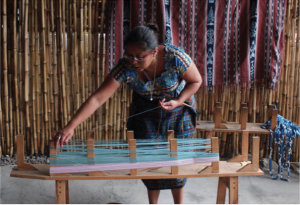
Finally, the weaving begins. Here, the women use a traditional backstrap loom, an instrument in use before the arrival of the Spanish. Weaving in this style is very time-consuming: a single scarf can take up to a week to make; a large blanket, a month or more.
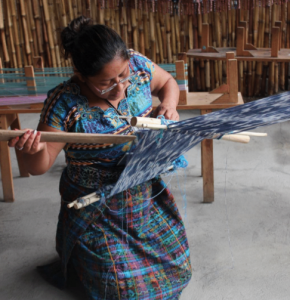
Mayan girls have little choice
The most striking aspect of weaving to me is not the process, nor the beautiful colors, but rather the fact that Mayan women begin learning how to weave at the age of six or seven.
I can’t help but feel that the expectation that Mayan girls weave, no matter how culturally significant, is forcing them into a field that they might not choose for themselves. In a traditional Maya context, when a girl is born, the midwife presents her with the various instruments of weaving, one by one, and songs are sung encouraging the baby to grow up to be a good weaver. The girl is destined to learn how to weave the minute she is born, leaving little opportunity or expectation for her to aspire to do anything else.
Although weaving and women are connected by culture and history, this culture is still highly patriarchal, creating a tension between the ancient ideas of women weaving and the modern ideas of women’s independence. This ancestry can work against Mayan women who have other ideas of what they would like to do, stopping them from progressing into the modern age.
Dress is linked to culture
Women are the keepers of Mayan culture and history, sometimes at a cost to their opportunities and life outcomes. While men have gradually begun to stop wearing their traje tipico (traditional Mayan clothing), women often continue to wear it, since they are usually not allowed to move much beyond the domestic realm.
Traje is extremely important to Mayan identity. It connects Mayan people to their ancestry, while also communicating where they come from. Each Mayan community’s traje is adorned with different patterns and colors that communicate what area of Guatemala they are from, and which Mayan language they speak. There are 21 different Mayan ethnic-linguistic communities in Guatemala, so a person’s traje speaks volumes about origins and identify. When men stop wearing their traje, they stop physically representing their cultural heritage, and this, in turn, slowly diminishes Mayan culture and traditions. The reason many men stop wearing their traje is due to their work in the modern economy, and to ongoing discrimination against Mayans. Yet, this transition to Western clothing in the form of cultural assimilation affects the persistence of Mayan culture. Growing numbers of Mayan parents have slowly stopped teaching their children the Mayan language, and many Mayan children, especially those growing up in the capital, never wear traje at all, in order to shield themselves from discrimination. All of this also helps erase Mayan culture.
So these weaving women hold a very special place in Mayan communities, since they are guardians of Mayan tradition.
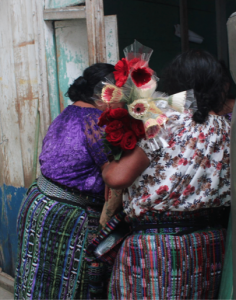
Despite their essential role as the keepers of Mayan culture and history, Mayan women who learn to weave are largely illiterate, according to the study “Women’s Work in Guatemala,” by Cleveland State University professor Bette R. Bonder and several colleagues. This type of disadvantage cannot be ignored, as it has a huge effect on opportunities available to these women. It also leaves the women susceptible to scamming by larger companies that pose as cooperatives interested in selling Mayan weaving products, but make off with most of the profits. These risks are one of the main reasons some Mayan women have formed weaving cooperatives, and groups such as Ethical Fashion Guatemala. This company works to protect Mayan women and their goods, by giving them a space to sell their items online, while allowing weavers to earn considerable profits.
Mayan women never before had an opportunity for global commerce, due to a lack of money, resources and Internet skills. Unlike many U.S.-run e-commerce sites, which take the lion’s share of profits for themselves, Ethical Fashion Guatemala takes only a 10 percent cut, to cover the costs of running the website, credit card fees and shipping. The rest is paid to the artisans. The company is also taking a stand against copycat websites selling Guatemalan knock-offs, and has begun filing for trademark protection for the products the weavers create.
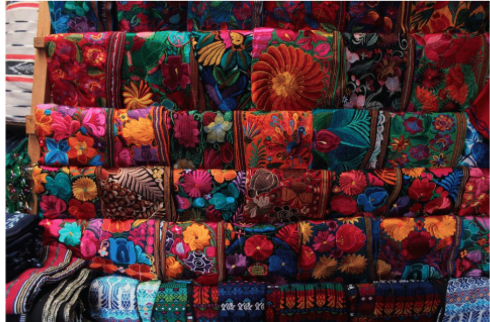
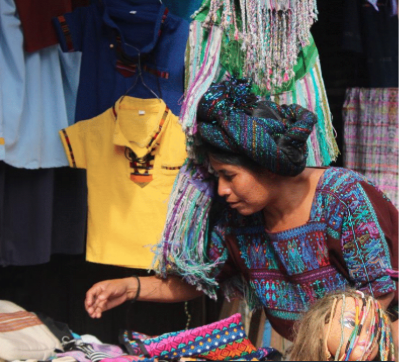
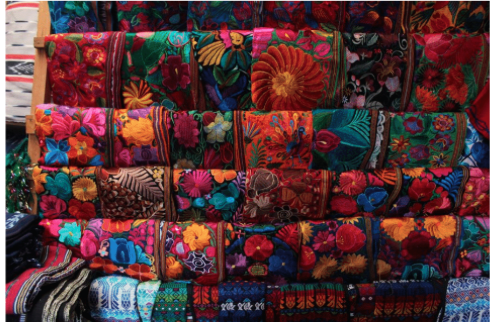
About the Author
Rebecca Koblin
Professor: Regina Marchi
Class: Media and Struggles for Democracy in Central America
Takeaway:
